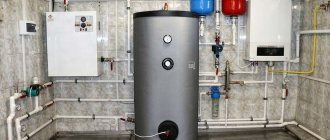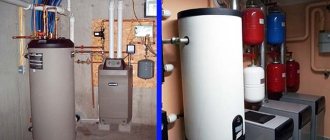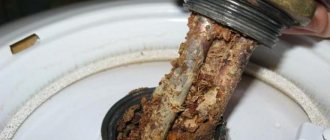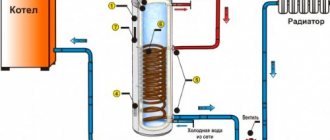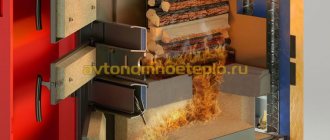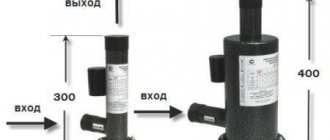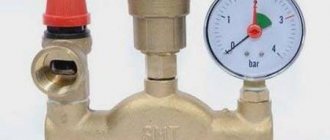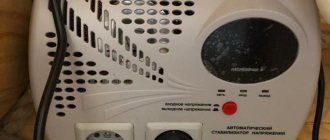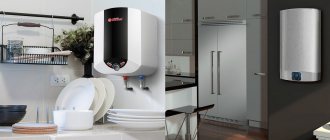There are several options for organizing hot water supply in a private home. The simplest of them is installing a double-circuit gas boiler. It does not require complex piping and constant supervision, and switches to DHW mode automatically when the faucet is opened in the kitchen or bathroom. The disadvantage of this solution, namely low productivity, appears when it becomes necessary to open both taps at the same time.
We propose to consider another method of supplying a private house with hot water, which consists of connecting an indirect heating boiler (IBC) to a single-circuit boiler.
The main advantages of installing BKN
A tank-type water heater is more difficult to install, and capital costs for equipping a boiler room also increase, but in the long term this option turns out to be the most attractive. A single-circuit boiler with an indirect heating boiler has several advantages:
- Large supply of hot water. Household models have a volume of up to 300 liters.
- It is possible to connect the boiler to a single-circuit boiler of any type: gas, liquid fuel, coal, wood.
- High reliability, no potential points of failure.
- The operation of the heating system does not depend on the DHW circuit. The boiler can be stopped for inspection or repair at any time, and any breakdown in a double-circuit boiler will leave its owner without heating and hot water.
Types of indirect heating boilers
An indirect heating boiler is a cylindrical storage tank placed in a heat-insulating casing. It is equipped with connecting pipes for connecting the coolant (supply and return), cold water inlet and hot water outlet. Some models (mostly large volumes) have the ability to connect a recirculation line.
Manufacturers of indirect heating boilers offer the following types of equipment:
- With pipe heat exchanger.
A coil is placed in a container with sanitary water through which the coolant passes. - Tank in tank.
The container with sanitary water is surrounded on all sides by a coolant jacket.
Some manufacturers optionally install electric heating elements that serve as a backup or additional source of energy. BKN may differ in the presence and composition of instrumentation and automation. Most boilers have built-in temperature sensors. Some models can be connected to automatic gas and pellet boilers.
Types of water heaters and their operating principles
Unlike models that run on electricity or gas, an indirect heating boiler (IBC) operates thanks to an external heat source. If the system is connected to heating, then the coolant is heated by solid fuel. This approach helps in the winter, but what to do in the summer, when the heating season is over?
Manufacturers produce combined systems: an additional heating element is placed in the tank, which can be powered by electricity or a solar collector. Read how to make an indirect boiler in a separate publication.
There are two types of water heaters:
- managed;
- without control.
The first ones are more expensive and easy to use, they work automatically. All that is needed:
- Connect the hot water inlet and outlet.
- Organize the supply of cold flow to the tank.
- Install a liquid distribution device.
Even equipment with a thermostat cannot heat up more than the coolant allows. For example, the boiler heats up to 40 degrees, which means the coolant will heat the water by a maximum of 40 degrees.
Devices without control operate automatically, depending on the boiler parameters. You will have to install the temperature sensor yourself and connect it to the heating system. After which the strapping is performed, which we will discuss in detail below.
When choosing, pay attention to additional functionality - it may be useful during operation. More expensive models can be equipped with an accumulation system . Thanks to improved insulation and a large tank volume, the liquid retains heat well in the absence of electricity.
There are also devices with recirculation . Fast heating is provided by three pipes. A hot stream moves along two of them, and a cold stream moves through one. An additional pipe can be used to connect clothes to the dryer.
Features of tanks and their installation
Indirect water heaters can be floor-mounted or wall-mounted. Wall-mounted ones reach a capacity of up to 150 liters. The shape of the tank is most often round. They are mounted on special brackets that are included in the kit.
Tanks with a displacement of 200 to 1500 are installed on the floor. They have side or rear hose connections. The base is often supported by legs. For large equipment you will have to allocate a separate room.
Boiler connection diagrams
In practice, two basic schemes are used for connecting an indirect heating boiler to the boiler: through a hydraulic arrow and through a three-way thermostatic valve with a servo drive. Depending on the boiler configuration, each of them can be made in several automation variations.
Via three-way valve
The connection diagram of the boiler to the boiler through a three-way valve allows you to implement DHW priority. The operating mode of the system is as follows:
- When the boiler is first started, the entire coolant heats the BKN.
- Upon reaching the set temperature in the boiler, the automation redirects the coolant flow into the heating system circuit.
- When the selection of hot water begins and its temperature drops, the automation again gives the command to heat the BKN.
There are wall-mounted gas boilers with a three-way valve and circulation pump installed inside. In their lower part you can see four pipes:
- gas connection;
- return;
- supply to the heating system;
- submission to BKN.
The return pipes from the boiler and heating system are connected into one through a tee. The thermostat built into the boiler is connected to the gas boiler. Single-circuit models with a three-way valve have a corresponding connector on the control board. It is also possible to adjust the flame of the gas burner depending on the operating mode of the boiler:
- While heating the water, the burner is turned on at full power, and the coolant temperature rises to 90 °C.
- When the boiler operates for heating, the burner power is set in accordance with the heat consumption of the house. The coolant temperature is reduced to the optimal value (usually about 60 °C).
If the boiler does not have a three-way valve and a circulation pump, they must be installed separately. You also need to provide power for the servomotor. When using a solid fuel or non-volatile gas boiler without a control board, to lower the temperature of the coolant in heating mode, you need to install a pump and distribution unit.
Via hydraulic separator
If the heating system has radiator and heated floor circuits connected through a hydraulic separator, it can also be used to power an indirect heating boiler. To implement DHW priority, an external microprocessor unit is required that will control the operation of the pumps: turn off the circulation through the heating circuits during the preparation of hot water in the boiler.
There is another scheme for connecting the boiler to the boiler - without DHW priority. The system will be cheaper, but its operation will be less efficient. The coolant temperature will need to be kept at 60 °C, accordingly the water in the boiler will be slightly colder.
Schemes and rules for connecting BKN
The connection diagram and installation features of an indirect heating boiler depend on the class of the device and the heating system in the house. It is necessary to choose the right installation location, focusing on the location of the boiler, pump insertion and existing wiring. Let's try to figure out what needs to be taken into account when installing heating equipment.
Option #1 – piping with a three-way valve
This is one of the most popular schemes, since when it is used, there is a parallel connection of the heating system and the BKN, equipped with shut-off valves. The boiler must be installed near the boiler, a circulation pump must be installed in the supply, then a three-way valve.
This scheme is successfully used if several heating devices are used, for example, two different boilers.
A three-way valve is a kind of switch that is controlled by a thermal relay. When the temperature drops, the automation is activated, and the coolant flow from the heating circuit is redirected to the BKN
Essentially, this is a priority system that ensures rapid heating of water in the boiler when the radiators are completely turned off for a while. As soon as the temperature rises to the set value, the three-way valve is activated again and returns the coolant to its previous direction - to the heating system. This piping method is useful for those who use the boiler constantly.
Option #2 – scheme with two circulation pumps
If the boiler is rarely used (for example, seasonally or on weekends) or there is a need for water whose temperature is lower than in the heating system, use a scheme with two circulation pumps. The first is installed on the supply pipe, directly in front of the BKN, the second - on the heating circuit.
The circulation pump is powered through a thermal relay, so it starts to operate only when the temperature drops below the required one. Heating accelerates when forced circulation is turned on
There is no three-way valve in this scheme; the piping is equipped using simple connecting tees.
Option #3 – piping with a hydraulic arrow
This connection is used for volumetric boilers (200 liters or more) and branched heating systems with many additional circuits. An example is the heating system in a two-story house, where, in addition to a multi-circuit radiator network, heated floors are used.
A hydraulic distributor (hydraulic arrow) is necessary to simplify the layout of the heating system and avoid installing recirculation pumps on each heating branch
The water gun equipment allows you to avoid thermal shock, since the water pressure in each circuit will be the same. It is quite difficult to make the piping according to this scheme yourself, so it is better to turn to professional installers.
Option #4 - using coolant recirculation
Recirculation is useful when there is a circuit that requires a constant supply of hot water - for example, a heated towel rail. If it is connected to the heating system, the coolant will constantly circulate, and the dryer will function and at the same time serve as a heating device.
The use of recirculation has one big advantage - you don’t need to wait for the water to heat up to the desired temperature, it will always be hot
But this scheme also has disadvantages. The main one is an increase in fuel costs, because constant heating of the water cooled in the circuit is required. The second disadvantage is mixing water in the boiler. Typically, hot water is located in the upper part, and from there it flows to the water supply points, where it is mixed with cold water, as a result of which the outlet temperature is slightly lower.
There are models of boilers with built-in recirculation, that is, with ready-made connections for connecting a heated towel rail. But it’s cheaper to buy a regular tank using tees for connection.
Option #5 – system with a non-volatile boiler
A distinctive feature of this scheme is the installation of the boiler at a higher level than the boiler and heating appliances. Preference is given to wall-mounted models that can be hung at a height of 1 m above the floor.
Floor-standing models specifically within this scheme are inferior to wall-mounted ones in heating speed and quality. The water temperature is much lower (about the same as in the return pipeline), therefore, the supply of hot water is less
The non-volatile type of heating is based on the application of the laws of gravity, therefore, the coolant will circulate even when the electricity is turned off. In normal mode, you can connect circulation pumps.
BKN strapping
To coordinate the operation of the boiler with the boiler and the DHW system, it is important to properly connect it. Most often, diagrams are found in equipment operation and maintenance manuals. But some manufacturers only refer to DIN 1988 “Technical rules for the installation of domestic hot water systems”. And if the piping is performed in violation of the standard requirements, the boiler is removed from the warranty.
General requirements
The water and coolant connections to the indirect exchange boiler must be quick-release. Connections between pipes and pipes are made using union nuts. So that the BKN can be dismantled to clean the storage tank or replace the magnesium anode without stopping the boiler, shut-off valves must be installed on the inlets.
Coolant side
As an example, consider the piping of a boiler connected to the system through a hydraulic separator. The BKN circuit must have its own circulation pump. The supply piping is performed in the following order (starting from the BKN inlet pipe):
- Detachable connection.
- Shut-off valve.
The return piping is a little more complicated:
- Detachable connection.
- Shut-off valve.
- Dirt filter.
- Circulation pump.
- Check valve.
From the water side
The procedure for piping the hot water outlet:
- Detachable connection.
- Shut-off valve.
- Expansion tank embedded through a tee.
- Shut-off valve.
The cold water inlet is tied in the following order:
- Detachable connection.
- Relief valve.
- Shut-off valve.
- Connection for connecting a pressure gauge.
- Drain valve.
- Pressure reducing valve.
- Check valve.
- Filter.
- Shut-off valve.
Installation of a pressure reducing valve is necessary to match the pressures in the supply line and in the BKN.
Recirculation line
If hot water is used from time to time, the part of it that is in the pipe has time to cool down. When opening a tap remote from the BKN, the user has to wait until it drains. In order to save money, a recirculation pump is installed in the piping on the DHW side, which periodically circulates water through the system.
Strapping options for different situations
Most often, when connecting an indirect heating boiler, three main schemes are used:
- option with three-way valve
- use of two circulation pumps
- use of a hydraulic boom.
In addition, it is worth considering the use of a recirculation system, which can significantly improve the quality of hot water in a private house or apartment.
How to use a three way valve?
When consuming a large amount of hot water, they most often use an indirect heating boiler connection using a three-way valve. In this case, it is necessary to create two heating circuits: the main one, which heats the room, and a separate circuit required to heat the water in the boiler. To distribute the coolant flow between these circuits, a three-way valve is used, which is controlled by the boiler thermostat.
A three-way valve in the indirect heating boiler piping circuit is used to regulate the direction of coolant flow. The valve is controlled by a boiler temperature sensor
This system works as follows. When the water temperature in the tank drops below the set value, the valve directs the coolant to the boiler heating circuit. After the water has heated to the required level, the valve returns the coolant flow to the main heating circuit. In this case, the main role is played by heating the water in the boiler tank, and not by the heating circuit.
Note! In areas with very hard water, it is recommended to use an indirect heating boiler with a three-way valve instead of a double-circuit boiler, the elements of which fail too quickly under such operating conditions.
For this type of system to work correctly, it is very important to set the thermostat correctly. The fact is that if the maximum value of the heating temperature of the water in the tank is higher than the heating temperature of the coolant in the boiler, the water in the boiler will be constantly heated. Switching to the heating circuit will not occur, since the maximum temperature in the boiler will not be reached.
Two pump system
Instead of a three-way valve, a system with two recirculation pumps and a check valve can be used. In this case, the installation of an indirect heating boiler also includes two parallel circuits: a heating circuit and a boiler circuit. A separate circulation pump is used to control each circuit.
In the indirect heating boiler piping scheme using two circulation pumps, the heating circuit and the boiler circuit are mounted in parallel, but the main role is played by the boiler circuit
Since the hot water supply line has priority, the circulation pump of the boiler circuit is installed before the heating system pump. To control the pumps, the same boiler temperature sensor is used, obeying the signals of which the pumps turn on and off. The two-pump scheme can be very convenient when using a heating system that includes two boilers. In this case, one boiler is completely used for heating the room, and the second is connected to both the heating system and the boiler.
When the water in the boiler cools, the coolant flow is directed to heat it, and at the end of the process it is returned to the heating system. A check valve is necessary so that the coolant flows do not mix.
There is no need to fear that the quality of heating of residential premises will suffer due to the use of a contour heating boiler. The water in the DHW system heats up very quickly, usually in less than an hour. During this short time, the rooms simply do not have time to cool down.
How does a hydraulic boom work?
In modern private houses and even in ordinary apartments, the heating system can be quite complex. In addition to the radiator line, it often includes a boiler heating circuit, a heated floor system, and other elements.
A hydraulic arrow in the circulation pump piping circuit is necessary to regulate coolant flows and compensate for pressure differences in individual parts of a complex heating system
Each such circuit is equipped with a separate circulation pump. In this case, the flows in various circuit circuits must be balanced. To control such multi-circuit heating systems, a hydraulic distributor is used, which may include a hydraulic arrow and a manifold. Pressure drops in individual circuits can also be neutralized using special balancing valves.
The more complex the heating system, the more carefully its installation should be carried out. It is best to entrust the design of connecting an indirect heating boiler using a hydraulic arrow to an experienced specialist, since it is quite difficult to adjust such a system “by eye”.
Indirect heating boiler safety group
The safety group is a mandatory element of the piping of a solid fuel boiler. It prevents the heat exchanger from rupturing when the maximum permissible pressure is exceeded and removes air from the system. The same safety group must be provided in an indirect heating boiler. It can be performed on a single collector or distributed throughout the system:
- a pressure gauge is installed on the front wall of the boiler;
- the relief valve is combined with the return valve (on the cold water supply);
- The air vent is mounted at the highest point at the DHW outlet.
How to connect an indirect heating boiler to a non-automated boiler - diagrams
The indirect heating boiler is heated by coolant from the boiler. Such a boiler cannot independently generate heat from an energy source, such as gas or electricity. It is a large container with a coil inside, through which the coolant heated by the boiler flows, which ensures water heating and the operation of the hot water supply.
Below we will consider the case when you need to connect an indirect heating boiler to a boiler that is not equipped with automation, which itself cannot control this device. Such boilers can be completely energy-independent - they operate without the slightest participation of electricity.
The nuance is that for the boiler we need at least 70 degrees at the outlet of the boiler, or better than 80 degrees, so that the water is heated as quickly as possible.
But it is possible that we need less in the radiator heating system - 40, 50 or say 60 degrees, or we don’t need to heat it up at all.
The boiler will have to be heated significantly, and a three-way valve with a thermal head will have to be used, which will regulate the temperature in the heating system by closing the outlet to it from the boiler side and redirecting it from the return.
Scheme
The supply and return bifurcate, one branch is closed to the radiators, the second passes through the indirect heating boiler. A circulation pump is installed in each branch.
The branches work alternately, and everything is controlled by a three-pin thermostat installed in the boiler (on the boiler). As long as the water temperature in the boiler is acceptable, the thermostat closes contact No. 1 - power supply to the heating system pump. As soon as the temperature drops below the value set on the thermostat (45 degrees), it switches, turns off the power supply circuit to the heating system pump and turns on the boiler pump.
At the heating supply there is a mixing valve with a thermal head, through which part of the return flow is mixed into the heating supply to make the liquid at the pump inlet at a given temperature - 30, 40, 50.... hail
Peculiarities
It is necessary to monitor the operation of the boiler and prevent a significant increase in the temperature at the boiler outlet, since the energy consumed by the heating system is limited by the valve.
If the temperature on the boiler rises to 90 degrees, the boiler is extinguished, the valve opens manually completely. The system can only operate with additional protection against cold return if the heat exchanger is cast iron.
Check valves on the boiler and heating returns will eliminate reverse current under the influence of turning on pumps in parallel circuits.
If the boiler is powerful, then its energy will be enough for both the boiler and the heating system. In this case, in order not to pull the boiler pump frequently, you need to connect it directly to the network, i.e. through a switch, so that it is possible to stop or turn off at any time for the summer season. Now the heating will work all the time, and the boiler will be turned on occasionally by the thermostat, after water is drawn from it.
With boiler thermostat
Now let's look at how you can connect a boiler to a boiler that has electrical control of the water temperature - a boiler thermostat is installed, with a knob for adjusting the water temperature.
The conflict of systems is still the same - for the heating system, for example, 50 degrees is enough, but we need to apply 80 degrees to the boiler so that it heats up quickly.
But in this case, we will control the heating of the boiler by turning on its pump and by heating the boiler to 80 degrees.
Two control relays will help with this:
- No. 1 for pumps, which, having received a command from the boiler thermostat, switches contacts - turns off the heating pump and turns on the boiler pump.
- No. 2 – turns on, parallel to the thermostat on the boiler, an additional overhead thermostat installed on the supply from the boiler and set to 80 degrees.
If the heat exchanger is cast iron, then the system must have protection against cold return.
How it works
Having received a command from the boiler thermostat (the water has cooled to 45 degrees and below), relay No. 1 turns off the heating and turns on the boiler pump. Relay No. 2, on the same command from the thermostat, connects in parallel to the boiler thermostat another one, which is set to 80 degrees and measures these degrees at the boiler flow.
Now the boiler, having received a command to accelerate from the overhead thermostat, heats up to 80 degrees and maintains this temperature. The boiler heats up quickly.
After heating to 55 degrees, the thermostat in the boiler breaks the circuit, relay No. 1 turns off the boiler pump and turns on the heating. Relay No. 2 breaks the circuit and turns off the overhead thermostat, now the boiler again focuses on the built-in thermostat with a setting of 50 degrees.
Everything returned to its original state, only the boiler was heated again to 55 degrees.
The water in the heating system may have time to cool down. If the boiler is cast iron, then applying cold water to the cast iron can destroy it. With cast iron boilers, the scheme can only be used with additional protection of the boiler from cold return.
In general, independently make connections for the boiler to non-automated boilers that do not know how to control a boiler, solid fuel, outdated, etc. You can do it yourself. We have just looked at how to connect a boiler.
Does the boiler need an expansion tank?
An indirect heating boiler contains a large volume of water, which expands as a result of heating. To compensate for the increase in volume, an expansion tank must be built into the system. Otherwise, the “excess” water will be drained through the excess pressure relief valve. The size of the expansion tank is selected based on 10-12% of the boiler volume. Expansion tanks for heating systems cannot be installed on hot water. They vary in performance characteristics and will fail very quickly.
If you have any questions about choosing or connecting indirect heating boilers to KUPPER boilers, you can ask them to our employees via online chat or by phone.
